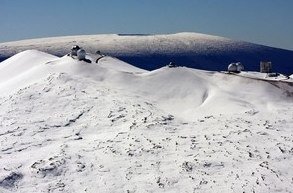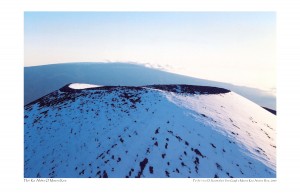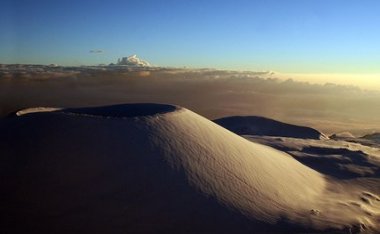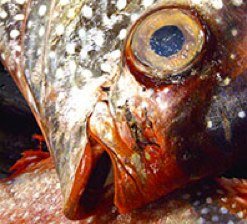Blog
News, updates, finds, stories, and tidbits from staff and community members at KAHEA. Got something to share? Email us at: kahea-alliance@hawaii.rr.com.
Understatement of the Month
From the Honolulu Advertiser coverage of the grounding and sewage release by the U.S. Navy’s 567-foot Port Royal:
The omission was one more bit of embarrassment heaped onto the 3 1/2-day spectacle of a 9,600-ton warship capable of shooting down ballistic missiles in space sitting helplessly aground in 17 to 22 feet of water just off Honolulu International Airport’s reef runway.
We’d like to officially submit “one more bit of embarrassment” as the understatement of the month.
Full article at: http://www.honoluluadvertiser.com/apps/pbcs.dll/article?AID=/20090211/NEWS08/902110398

How to Biofuel?
Check out Andrew Alan McNarie’s excellent piece on the present (and possible future) of biofuels in Hawaii in the Hawaii Independent.
In 2002, the state Legislature enacted provisions in Hawai‘i Revised Statutes, Section 171-95, to allow the Board of Land and Natural Resources to directly negotiate leases of state land to the companies producing vegetation-derived “biofuels.”
HRS 171-95 is bearing fruit (and trees, and bushes). Efforts are underway to produce biodiesel and biofuel-generated electricity on Maui, O‘ahu and Kaua‘i. At least six different companies are interested in producing biofuel on the Island of Hawai‘i.
But there have been setbacks. After a bruising series of public meetings on the Big Island, one biofuel firm has repudiated its own “Agreement in Principle” to lease state land, and legislators are reconsidering the BLNR’s authority to negotiate such agreements.
See the full article at: http://www.thehawaiiindependent.com/hawaii/2009/02/04/the-bio-fuel-land-rush-part-i-blnr-bobbles-biofuel-agreements/
Bad Mauna Kea Bills Move Through Legislature

From Rob Perez’s excellent coverage of the Mauna Kea bills currently moving through the state legislature:
Two bills (HB 1174 and SB 502) giving UH authority over the 11,000-plus acres of ceded lands it leases from the Department of Land and Natural Resources have been approved by two committees each in the House and Senate, worrying environmentalists, Native Hawaiian groups and others.
The bills permit UH to regulate public and commercial uses of the land, and critics believe that authority would be broadly applied. Lawmakers call the legislation a “work in progress.”
“This is a very, very bad idea,” said Marti Townsend, program director of KAHEA: The Hawaiian-Environmental Alliance.
Critics say transferring such oversight to UH would be a huge mistake in light of the school’s poor track record on Mauna Kea and the dangerous precedent the action would set, essentially turning over responsibility for the land to its leaseholder or developer.
See full article at: http://www.honoluluadvertiser.com/article/20090222/NEWS03/902220351/1001
Kanaka Scholars Stand Up for Mauna Kea
 Mahalo nui loa to the dozens of Kanaka Maoli (Native Hawaiian) scholars who submitted this statement in support of protecting the sacred summit of Mauna Kea. The University of Hawaii is seeking to take over control of the summit from the Department of Land and Natural Resources because they lost the lawsuit in 2007 that held the DLNR must manage the summit for the conservation of the natural and cultural resources there, not telescope construction. For 40 years, the University of Hawaii has facilitated the destruction of the public trust lands on the summit by foreign corporations that own and operate dozens of telescopes. You can take action, too, by submitting testimony online – just click here.
Mahalo nui loa to the dozens of Kanaka Maoli (Native Hawaiian) scholars who submitted this statement in support of protecting the sacred summit of Mauna Kea. The University of Hawaii is seeking to take over control of the summit from the Department of Land and Natural Resources because they lost the lawsuit in 2007 that held the DLNR must manage the summit for the conservation of the natural and cultural resources there, not telescope construction. For 40 years, the University of Hawaii has facilitated the destruction of the public trust lands on the summit by foreign corporations that own and operate dozens of telescopes. You can take action, too, by submitting testimony online – just click here.
Kanaka Maoli Scholars Against Desecration
Statement on Mauna Kea – February 17, 2009
We declare our opposition to SB 992/HB 1174 and SB 502/HB 1370 and any other legislation bills that would transfer Mauna Kea to the University of Hawai`i (UH). These current legislative proposals would give the UH complete management authority over Mauna Kea and allow implementation of a plan that has no limit on telescope construction, would close public access to the summit, and exempt UH from public oversight in the name of development.
Mauna Kea is a sacred summit, which is already being desecrated by the existing science telescopes. The Hawai`i revised statute 711-1107 on desecration specifically states that no one may commit the offense of desecrating “a place of worship or burial,” and the statute defines “desecrate” as “defacing, damaging, polluting, or otherwise physically mistreating in a way that the defendant knows will outrage the sensibilities of persons likely to observe or discover the defendant’s action.” If this legislation passes, state legislators would be violating their own state law.
These legislative proposals also interfere with on-going litigation on the current regulations governing Mauna Kea. We would also like to remind state representatives and the general public that in the recent Third Circuit Court case regarding the management of Mauna Kea, the court ruled in favor of the Plaintiffs—Kealoha Pisciotta, President of Mauna Kea Anaina Hou; Debbie Ward and Nelson Ho, Co-Chairs of Mauna Kea Issues Committees, Sierra Club Hawai`i Island Chapter; Ali`i `Ai Moku, Paul K. Neves of the Royal Order of Kamehameha I, Moku of Mamalahoa Heiau Helu `Elua; and Clarence Ku Ching, individual Native Hawaiian Practitioner—and against the UH and the state Board of Land and Natural Resources (BLNR) for violation of the regulations protecting Mauna Kea as a conservation district. This lawsuit is currently on review before the Intermediate Court of Appeals (ICA) after the University appealed the lower court ruling against them. Though the University only recently withdrew its appeal from the ICA, counterclaims that go to the fundamental merits of this issue remain before the ICA.
Besides blatant desecration, and interference in on-going litigation, the negative environmental effects are numerous. As noted in the Testimony of the Plaintiffs regarding this legislation, two reports by the State Auditor have found that UH’s misuse and the BLNR’s failed oversight is “inadequate to ensure the protection of natural resources, and neglected …the cultural value of Mauna Kea.” Their report further stated that the University’s Institute for Astronomy “focused primarily on the development of Mauna Kea and tied the benefits gained to its research program,” and that its focus on telescope construction has been “at the expense of neglecting the site’s natural resources.” Also, in 2005, an Environmental Impact Statement required by federal court order found that the cumulative impact of telescope activities on Mauna Kea has had a “substantial, adverse, and significant” impact.
The current proposals also violate the land claims of the Hawaiian nation. These legislative attempts to transfer a portion of the Hawaiian Kingdom Crown and Government Lands of which Mauna Kea is a part, is in direct contravention of the Hawai`i State Supreme Court’s holding in OHA v. Housing and Community Development Cororation of Hawai`i, 2008. The Hawaii Supreme Court barred the transfer of this land base by the state. If this legislation passes, state legislators would be violating the state Supreme Court ruling.
This exploitative venture proposed by this legislation must be stopped because the entire scheme promotes the ongoing violation of the sacred summit of Mauna Kea; it would be irresponsible and bad public policy, as well as a continued abuse of state power.
J. Leilani Basham, Ph.D., Assistant Professor, Hawaiian Studies, University of Hawai`i at West O`ahu
Kamanamaikalani Beamer, Ph.D., Mellon-Hawai`i Postdoctoral Fellow, Kohala Center
Maenette K.P. Ah Nee-Benham, Ed.D., Dean of Hawai`inuiakea School of Hawaiian Knowledge, University of Hawai`i, Mānoa
Kealani Robinson Cook, Ph.D. Candidate, Department of History, University of Michigan
J. Noelani Goodyear-Ka`ōpua, Ph.D., Assistant Professor, Political Science, University of Hawai`i at Mānoa
Lisa Kahaleole Hall, Ph.D., Assistant Professor, Women’s Studies, Wells College
Sydney Lehua Iaukea, Ph.D., Mellon-Hawai`i Postdoctoral Fellow, Kohala Center
Kū Kahakalau, Ph.D., founder and director of Kanu o ka ‘Āina New Century Public Charter School
Lilikalā Kame`eleihiwa, Ph.D., Professor, Kamakakūokalani Center for Hawaiian Studies, University of Hawai`i at Mānoa
Val Kalei Kanuha, Ph.D., M.S.W., Associate Professor of Sociology, University of Hawai`i at Mānoa
Kēhaulani Kauanui, Ph.D., Associate Professor, Anthropology and American Studies, Wesleyan University
Brandy Nalani McDougall, Ph.D. Candidate, English, University of Hawai`i, Mānoa
Noenoe K. Silva, Ph.D., Associate Professor, Political Science, University
of Hawai`i at Mānoa
Ty Kawika Tengan, Ph.D., Associate Professor, Anthropology and Ethnic Studies, University of Hawai`i at Mānoa
Lani Teves, Ph.D. Candidate, Program in American Culture, University of Michigan
Haunani-Kay Trask, Ph.D., Professor, Kamakakūokalani Center for Hawaiian Studies, University of Hawai`i, Mānoa
Liza Keanuenueokalani Williams, Ph.D. student, New York University
Defend the Sacred Summit of Mauna Kea
Your help is needed right now. Lobbyists for the University of Hawaii, backed by powerful foreign telescope-developers, are pushing hard to take control of Mauna Kea’s public trust resources and override the conservation laws currently barring further development on our sacred summits. If successful, they will use this authority to write their own rules, approve their own permits, and shut-out the public. Public trust resources cannot be protected if the developers are allowed to police themselves.

You can help stop UH’s land-grab on Mauna Kea’s sacred summit. After 40 years of mismanagement, tell the State Land Board and the Legislature that enough is enough!
“The University’s lobbyists will say anything to get their way. I heard them tell Legislators they had community consent. I am from the community and tell you what, they have nothing of the sort.” — Kukauakahi Ching, Native Hawaiian Practitioner.
Our sacred summits — Mauna Kea and Haleakala — are protected by law as conservation districts. These are public trust ceded lands–Hawaiian lands–held by the state in trust for the people of Hawaii. Yet, today Mauna Kea’s public lands are exploited by foreign corporations and the University, who are profiting from telescope activities on the summit at the public’s expense.
“The rent from the foreign telescope-owners is 30 years past due–they have paid only $1 a year to misuse Mauna Kea. If the state had been collecting the $50 million dollars a year from these foreign telescope-owners, like we suggested to them years ago, we would not have these budget shortfalls now. Remember, $50 million in 1 year is $100 million in just 2 years. They owe the people of Hawaii for 30 years of back rent. How dare they suggest to short-change the taxpayers now.” –Kealoha Pisciotta, President Mauna Kea Anaina Hou.
Forty years of uncontrolled telescope construction has desecrated cultural sites, contaminated the ground above the primary aquifer, and destroyed 90% of the endemic Wekiu’s habitat. Today, developers are vying to build two new telescopes (along with roads, parking lots, office buildings, and gift shops) on undeveloped habitat around the summit area. One of them — owned by the California Thirty Meter Telescope Corporation — is larger than all the current telescopes combined and will bulldoze the last pristine peak near the summit.
The only thing stopping them is the law. That is why the University is working hard to overturn the laws that currently protect our sacred summits and limit telescope construction. Two courts of law and two state audits have already found that the telescope industry violated the state and federal laws meant to protect Mauna Kea. The only way their future telescope construction plans can go forward is for the University and the telescope developers to change and exempt themselves from these protective environmental laws.
This latest bid to take over Mauna Kea has two fronts:
1. Pressure the Land Board to adopt an illegitimate management plan that limits public access, dictates religious ceremony, and allows UH and telescope developers to pocket public money,
2. Lobby the Legislature to pass one of four bills that will hand-over authority for managing Mauna Kea to the primary developer of the summit, the University of Hawaii.
All of it comes down to the University’s same, long-sought goal: make it easier to exploit Mauna Kea for money. The latest proposal on the table would allow the University to restrict public access (including how and when Hawaiians may worship at the sacred summit), pocket all the money made on Mauna Kea, and exempt themselves from public oversight. This is a public policy and legal nightmare!
“The University wants to gate the road to Mauna Kea–the road was paid for by taxpayers, it’s a public road. The University wants to require Hawaiians to get a permit to worship–Mauna Kea belongs to Ke Akua, they cannot lock the people out of the temple. Even if Hawaiians could get a permit, it would mean they couldn’t bring their non-Hawaiian friends and ohana to ceremony. This is discrimination! Who is the University to say who can and cannot worship?” — Paul Neves, Alii Ai Moku, Royal Order of Kamehameha I.
Your voice can help preserve the sacred temple and delicate ecosystem of Mauna Kea. Take action now to tell the Legislature and the Land Board that Mauna Kea is still not for sale.
The Old Wheel that Worked
 Kauai-based journalist Joan Conrow has written an excellent piece featuring Uncle Isaac Harp and his efforts to fundamentally change Hawaii’s broken system of fisheries management.
Kauai-based journalist Joan Conrow has written an excellent piece featuring Uncle Isaac Harp and his efforts to fundamentally change Hawaii’s broken system of fisheries management.“We need to stop figuring out how to be a new wheel and go back to the old wheel that worked,” Harp says. “We need to get back into ahupua‘a management. It’s not that complicated.”
Read the full article at: http://honoluluweekly.com/cover/2009/02/woe-fish/
Dead Female Humpback found in Kekaha
Female humpback whale calf will be buried at the Pacific Missile Range Facility (PMRF), perhaps appropriate–since PMRF is the place where much of the high intensity sonar activity in Hawaii is centered. The Navy 20 years ago placed sonar devices on the ocean floor off the west coast of Kauai to detect and track underwater activity.
Maybe we can count this one against the 20 serious injury or mortality ‘takes’ for seven species of marine mammals the Navy requested a few years ago. Sigh.
From the Associated Press:
Officials are conducting a necropsy on a dead humpback whale calf that washed ashore in western Kauai this week.
A veterinarian, National Oceanic and Atmospheric Administration officials and the Hawaii Pacific University Marine Mammal Response Team arrived on Kauai on Tuesday to determine how the whale died. A Kauai cultural practitioner met the group and conducted appropriate cultural practices over the remains. NOAA said the whale is 17 feet long and is female. The cultural practitioner is expected to return to conduct ceremonies for the whale, and the remains will be buried on site at the Pacific Missile Range Facility. A tour boat captain spotted the dead whale in the vicinity of Kokole Point in Kekaha at about 8:45 a.m. Monday.






